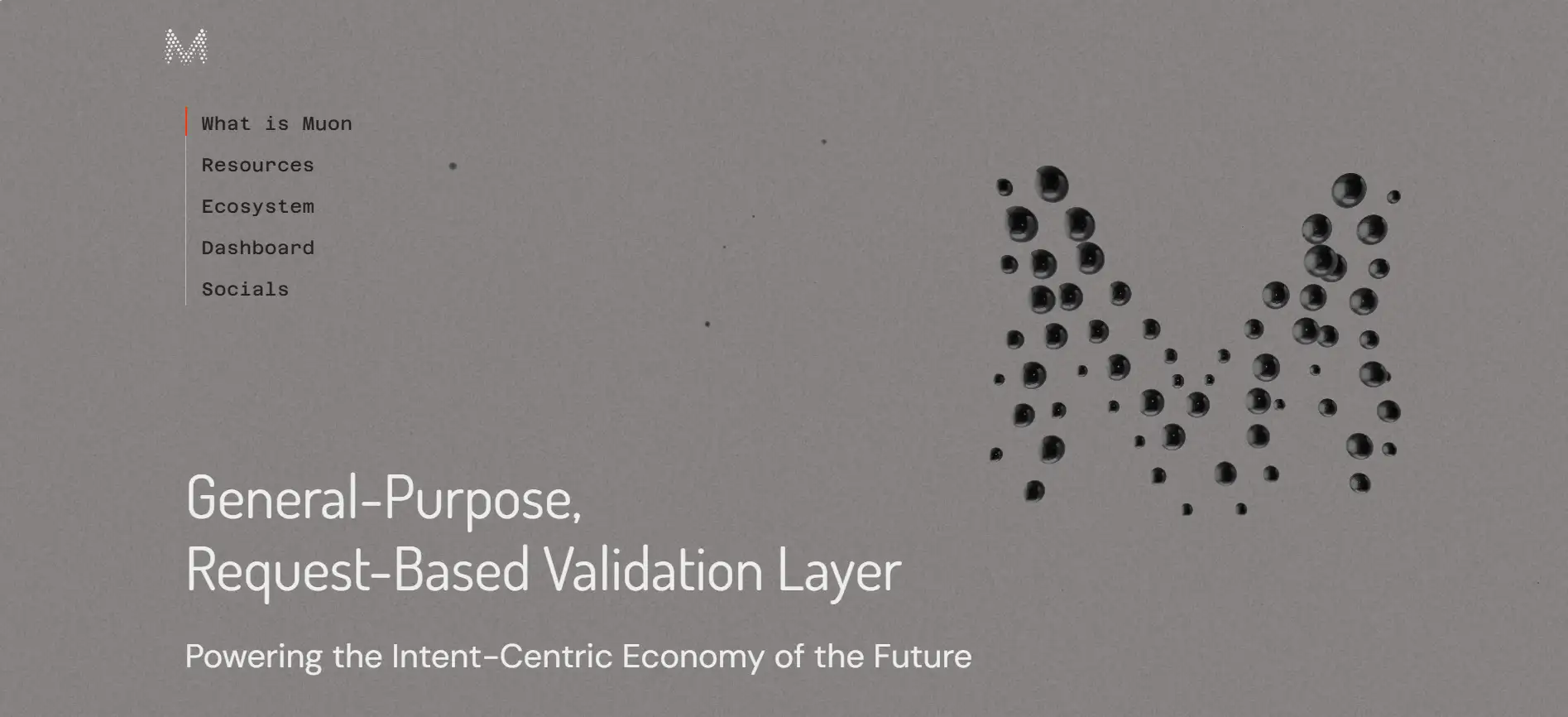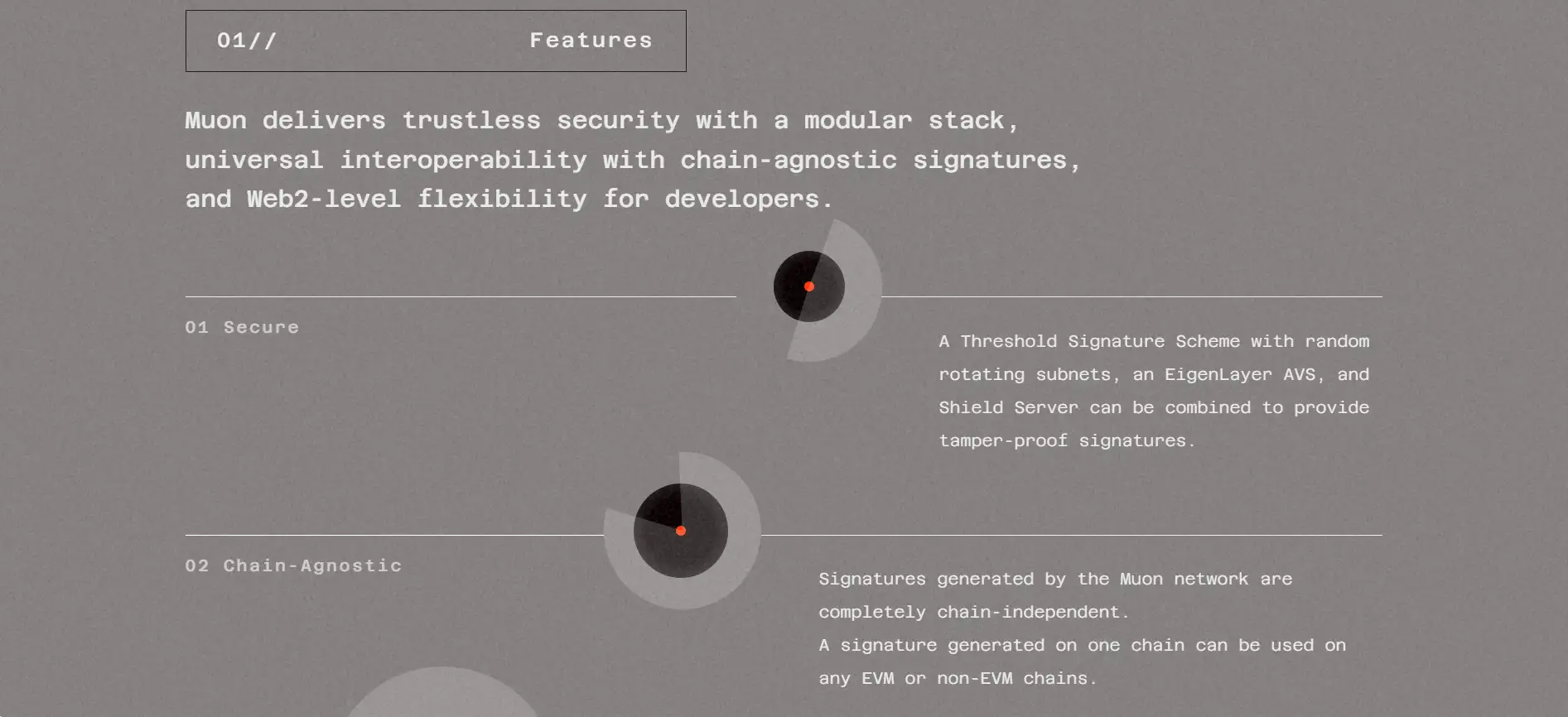About Muon Network
Muon is a general-purpose validation layer built to support the intent-centric economy of the future. It offers a modular and programmable architecture, designed to bridge the scalability, interoperability, and flexibility gaps that exist in Web3. Acting as a decentralized backend for dApps, Muon enables secure, off-chain data validation and computation before the information is transmitted to any blockchain.
Founded in 2022 by a group of experienced Web3 builders, the vision behind Muon was to create a flexible system that acts as the missing backend layer in the Web3 stack. After successfully deploying the ALICE testnet and later the Pion canary network, the full Muon Protocol launched on April 9, 2025, on the Avalanche blockchain. Since then, Muon has established itself as a crucial component in powering trustless and scalable dApps across DeFi, gaming, infrastructure, and more.
Muon operates as a request-based validation layer that introduces a Web2-style backend to the Web3 world. In traditional Web2 architectures, applications consist of a frontend, a backend to process requests, and a database. While smart contracts in Web3 combine the database and logic layers, they lack a native backend layer—this is the gap Muon fills.
By functioning as a programmable backend, Muon allows developers to perform off-chain operations, fetch data, and validate it before submitting results to any chain. This architecture significantly enhances the potential of dApps by removing performance and logic limitations inherent in smart contract execution. The protocol employs MuonApps—micro-validators that run custom logic coded in high-level languages like JavaScript—to handle these tasks. These apps are not con...
The project’s development began with the launch of a POA network in 2022, followed by the ALICE testnet in January 2023, which featured over 1,500 independently verified nodes. This led to the deployment of the Pion canary network, including tradable tokens and over 1,000 active nodes. In April 2025, Muon was officially launched on Avalanche following a successful community vote and migration plan from Pion, including structured staking and vesting.
The network’s chain-agnostic design allows signatures generated by Muon to be used across both EVM and non-EVM chains, a crucial feature for multi-chain interoperability. Its multi-layer security stack includes TSS (Threshold Signature Scheme), EigenLayer AVS, and Shield Server for tamper-proof validation. Notable applications built on Muon include Derand (a random number generator), AI Safe (a secure agent wallet), ...
While comparable to solutions like Chainlink, Band Protocol, and API3, Muon differentiates itself through its fully modular validation stack, flexible development environment, and real-time use-case support...
Muon Network provides numerous benefits and features that make it a standout project in the Web3 infrastructure landscape:
- Modular Security Stack: Muon combines TSS, EigenLayer AVS, and Shield Server to deliver tamper-resistant validation tailored to a dApp’s specific needs.
- Chain-Agnostic Signatures: Muon-generated signatures work across all EVM and non-EVM chains, allowing developers to build cross-chain dApps effortlessly.
- Web2-Level Developer Flexibility: MuonApps are coded using high-level programming languages, allowing fast development and custom validation logic without low-level smart contract constraints.
- Micro-Validator Architecture: Each MuonApp functions like a mini-backend that processes requests and delivers signed data, expanding the capabilities of Web3 applications.
- Composable and Scalable: Apps built on Muon can be reused, upgraded, or combined to support complex decentralized ecosystems.
- Real-World Use Cases: From random number generation to AI wallet interaction and secure multi-chain bridging, Muon supports a variety of functional integrations.
Muon Network offers an intuitive pathway for developers and users to get started:
- Visit the Website: Go to the official Muon Network website to explore use cases, documentation, and dashboards.
- Read the Documentation: Access the full dev guides and API references at docs.muon.net for in-depth technical details.
- Explore the Ecosystem: Learn about MuonApps like Derand, MetaBridge, and AI Safe to understand real-world applications.
- Use the Dashboards: Monitor validator performance or delegate node power via the Muon Node Dashboard.
- Connect with the Community: Join the discussion on Discord and Twitter for the latest updates.
- Deploy a MuonApp: Start coding your own micro-validator using high-level languages and deploy on Muon to perform off-chain computations.
- Verify Data Trustlessly: Once deployed, use your MuonApp to fetch, verify, and sign data that can be used on any blockchain.
Muon Network FAQ
Muon acts as the backend layer missing in typical Web3 architecture. In Web2, applications are built with a frontend, backend, and database. While smart contracts can handle data storage and logic, they lack a backend to process off-chain tasks. Muon fills this gap by providing a decentralized validation layer where off-chain computations and data processing happen securely before being submitted to the blockchain.
MuonApps are customizable micro-validators built on top of Muon that execute backend logic off-chain. Unlike smart contracts, which are limited by gas costs and on-chain constraints, MuonApps can use high-level languages like JavaScript, access Web2 and Web3 data, and are not isolated by chain-specific logic. This allows developers to build powerful, flexible components that operate like traditional backend services while still being cryptographically verifiable.
Through its chain-agnostic architecture, Muon allows signatures generated on one chain to be valid across any other chain, EVM or non-EVM. This is possible because the signatures are created by Muon’s decentralized validator network and are independent of any specific blockchain. As a result, developers can save time and gas by generating a single trusted output and verifying it wherever needed.
AI Safe, a dApp built on Muon, demonstrates how the network supports AI agents by enabling them to operate in a trustless and autonomous way. Muon provides real-time, verifiable data to agents, allowing them to interact with smart contracts, sign transactions, and make decisions without human intervention—while maintaining security and integrity via Muon’s validation layer.
Muon enables developers to offload resource-intensive operations to off-chain micro-validators (MuonApps). These apps process logic, aggregate data, or generate random numbers, and then return verifiable signatures that can be validated on-chain. This avoids the high gas costs and technical limitations of executing such logic in smart contracts, while preserving trust and decentralization.
You Might Also Like












